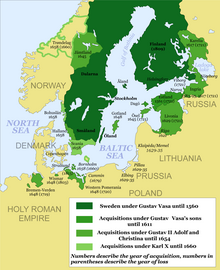
The history of Finland begins around 9,000 BC during the end of the last glacial period. Stone Age cultures were Kunda, Comb Ceramic, Corded Ware, Kiukainen, and Pöljä cultures. The Finnish Bronze Age started in approximately 1,500 BC and the Iron Age started in 500 BC and lasted until 1,300 AD. Finnish Iron Age cultures can be separated into Finnish proper, Tavastian and Karelian cultures. The earliest written sources mentioning Finland start to appear from the 12th century onwards when the Catholic Church started to gain a foothold in Southwest Finland.

The provinces of Sweden are historical, geographical and cultural regions. Sweden has 25 provinces; they have no administrative function, but remain historical legacies and a means of cultural identification as pertains, for example, to dialects and folklore.
The Basic Laws of Sweden are the four constitutional laws of the Kingdom of Sweden that regulate the Swedish political system, acting in a similar manner to the constitutions of most countries.
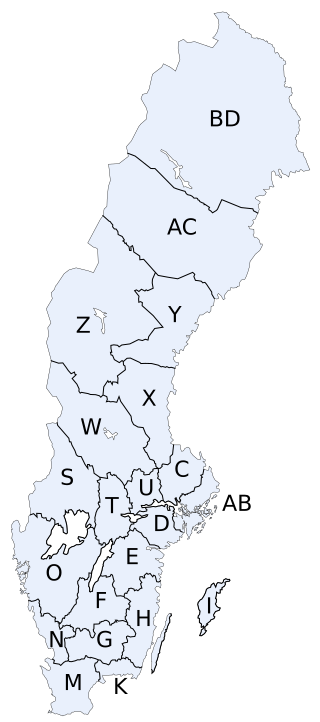
The counties of Sweden are the top-level geographic subdivisions of Sweden. Sweden is today divided into 21 counties; however, the number of counties has varied over time, due to territorial gains/losses and to divisions and/or mergers of existing counties. This level of administrative unit was first established in the 1634 Instrument of Government on Lord Chancellor Count Axel Oxenstierna's initiative, and superseded the historical provinces of Sweden in order to introduce a more efficient administration of the realm. At that time, they were what the translation of län into English literally means: fiefdoms. The county borders often follow the provincial borders, but the Crown often chose to make slight relocations to suit its purposes.
Riksdag of the Estates was the name used for the Estates of Sweden when they were assembled. Until its dissolution in 1866, the institution was the highest authority in Sweden next to the King. It was a Diet made up of the Four Estates, which historically were the lines of division in Swedish society:

The Dominions of Sweden or Svenska besittningar were territories that historically came under control of the Swedish Crown, but never became fully integrated with Sweden. This generally meant that they were ruled by Governors-General under the Swedish monarch, but within certain limits retained their own established political systems, essentially their diets. Finland was not a dominion, but an integrated part of Sweden. The dominions had no representation in the Swedish Riksdag as stipulated by the 1634 Instrument of Government paragraph 46: "No one, who is not living inside the separate and old borders of Sweden and Finland, have anything to say at Riksdags and other meetings..."
The 1810 Act of Succession is one of four Fundamental Laws of the Realm and thus forms part of the Swedish Constitution. The Act regulates the line of succession to the Swedish throne and the conditions which eligible members of the Swedish Royal Family must abide by in order to remain in it.
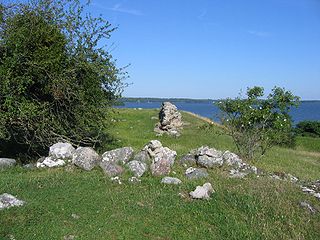
The Swedish nobility has historically been a legally and/or socially privileged class in Sweden, and part of the so-called frälse. The archaic term for nobility, frälse, also included the clergy, a classification defined by tax exemptions and representation in the diet. Today the nobility does not maintain its former legal privileges although family names, titles and coats of arms are still protected. The Swedish nobility consists of both "introduced" and "unintroduced" nobility, where the latter has not been formally "introduced" at the House of Nobility (Riddarhuset). The House of Nobility still maintains a fee for male members over the age of 18 for upkeep on pertinent buildings in Stockholm.

The estates of the realm, or three estates, were the broad orders of social hierarchy used in Christendom from the Middle Ages to early modern Europe. Different systems for dividing society members into estates developed and evolved over time.
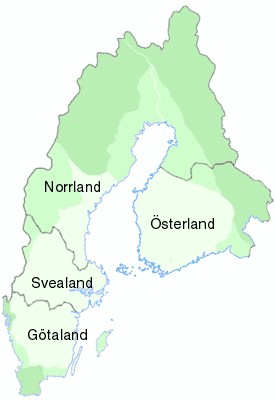
Sweden–Finland is a Finnish historiographical term referring to Sweden from the twelfth century to the Napoleonic Wars. In 1809, the realm was split after the Finnish War. The eastern half came to constitute the autonomous Grand Duchy of Finland, in personal union with Imperial Russia.

The Diet of Finland, was the legislative assembly of the Grand Duchy of Finland from 1809 to 1906 and the recipient of the powers of the Swedish Riksdag of the Estates.

The Diet of Porvoo, was the summoned legislative assembly to establish the Grand Duchy of Finland in 1809 and the heir of the powers of the Swedish Riksdag of the Estates. The session of the Diet lasted from March to July 1809.
Grand Duke of Finland, alternatively the Grand Prince of Finland, was, from around 1580 to 1809, a title in use by most Swedish monarchs. Between 1809 and 1917, it was the official title of the ruler of the autonomous Grand Duchy of Finland, who was also the Emperor of Russia. The anachronistic female form of the title in English would be Grand Duchess of Finland. The only women to have used the title were the Swedish queens regnant Kristina and Ulrika Eleonora. A few crown princes of Sweden also were called Grand Duke of Finland.

The Grand Duchy of Finland, also translated as Grand Principality of Finland, was the predecessor state of modern Finland. It existed between 1809 and 1917 as an autonomous part of the former Russian Empire.

The 1772 Instrument of Government was the constitution of the Kingdom of Sweden from 1772 to 1809. It was promulgated in the wake of the Revolution of 1772, a self-coup mounted by King Gustav III, and replaced the 1720 Instrument of Government, which had been in force for most of the Age of Liberty (1719-72). Although in theory the 1772 Instrument merely readjusted the balance of power between the Crown and the Riksdag of the Estates, without changing Sweden's status as a constitutional monarchy, in practice it is generally seen as instituting an absolute monarchy, especially after its modification in 1789 by the Union and Security Act, which further strengthened royal power at the expense of the Riksdag. It remained in force throughout the Gustavian era, until replaced by the 1809 Instrument of Government as a result of the Coup of 1809.
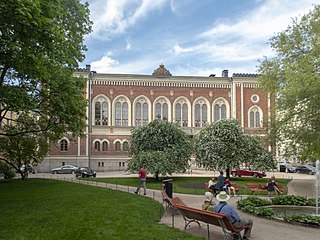
The House of Nobility either refers to the institution of the Finnish nobility or the palace of the noble estate. The Finnish nobility was until 1906 the first of the four estates of the realm.
The Finnish nobility was historically a privileged class in Finland, deriving from its period as part of Sweden and the Russian Empire. Noble families and their descendants are still a part of Finnish republican society, but except for the titles themselves, no longer retain any specific or granted privileges. A majority of Finnish nobles have traditionally been Swedish-speakers using their titles mostly in Swedish. The Finnish nobility today has some 6,000 male and female members.

Denmark–Norway was an early modern multi-national and multi-lingual real union consisting of the Kingdom of Denmark, the Kingdom of Norway, the Duchy of Schleswig, and the Duchy of Holstein. The state also claimed sovereignty over three historical peoples: Frisians, Gutes and Wends. Denmark–Norway had several colonies, namely the Danish Gold Coast, the Nicobar Islands, Serampore, Tharangambadi, and the Danish West Indies. The union was also known as the Dano-Norwegian Realm, Twin Realms (Tvillingerigerne) or the Oldenburg Monarchy (Oldenburg-monarkiet)

The Province of Oulu was a province of Finland from 1775 to 2009. It bordered the provinces of Lapland, Western Finland and Eastern Finland and also the Gulf of Bothnia and Russia.

In Swedish and Finnish history, Finland under Swedish rule is the historical period when the bulk of the area that later came to constitute Finland was an integral part of Sweden. The starting point of Swedish rule is uncertain and controversial. Historical evidence of the establishment of Swedish rule in Finland exists from the late 13th century onwards.
